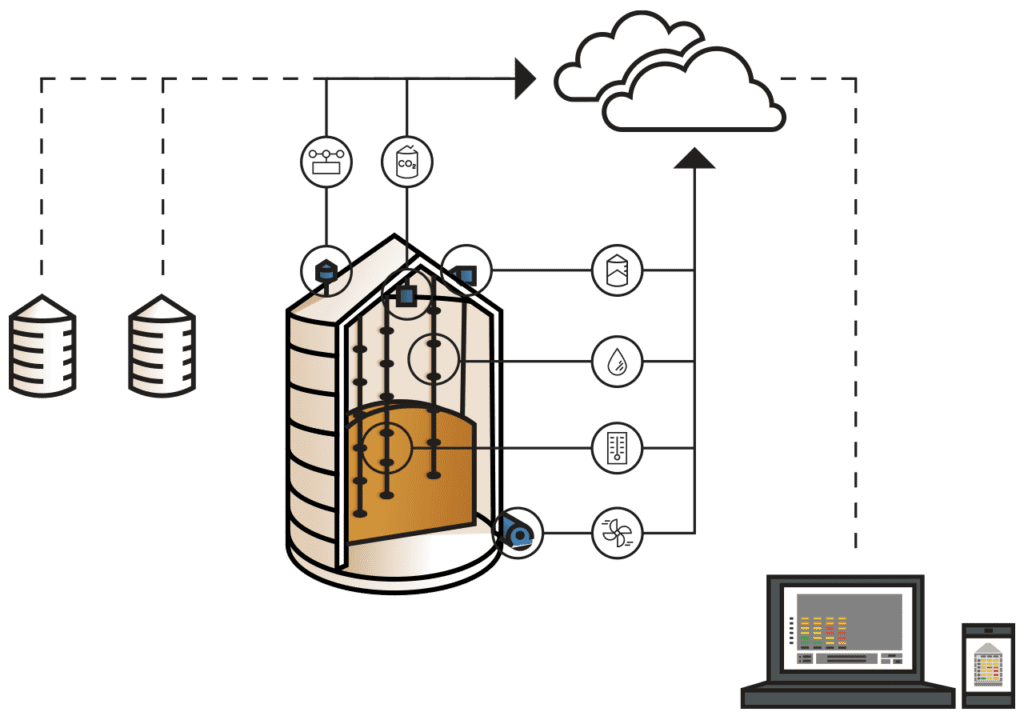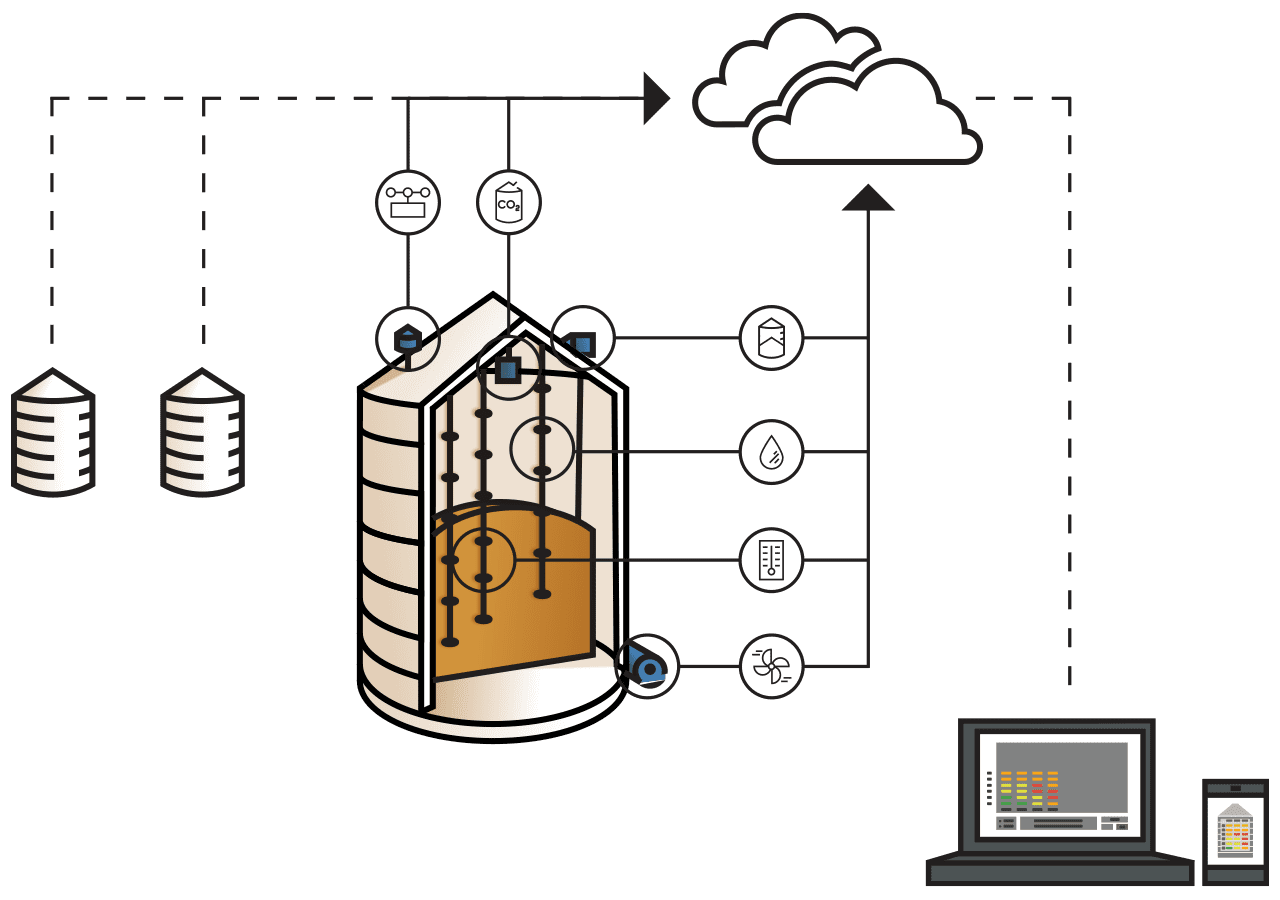Author Anne Lamott wrote a book on writing called Bird by Bird. She titled the book after an incident she witnessed between her father and brother when she was growing up.
It was a Saturday morning. Her brother had a big school research project on birds that was due the following Monday. Although he’d gotten the assignment three weeks prior, he hadn’t started yet. He sat at the kitchen table on the verge of tears over the task he faced. Overwhelmed, he was ready to give up before he started.
“How can I possibly do this all by Monday?” he asked his father.
“Bird by bird, son,” he answered. “Bird by bird.”
Have you ever felt like Lamott’s brother? All these new technologies coming at you. So much to learn, and so much to pay for. It can feel so overwhelming you want to throw up your hands and do nothing.
But imagine the day when you manage every aspect of your farm with ease and precision. Imagine knowing the exact condition of stored grain in all your bins from the comfort of your kitchen table 24/7.
How do you get there from here? Bird by bird – technology by technology. You don’t have to do it all at once, you just have to start.
A Path to Painlessly Breaking into Smart Farming
Precision planting, variable rate fertilizing, GPS auto harvesting and spraying, and remote grain monitoring are examples of Smart Farming. You’ve seen them at shows, or heard about them from others. You may even be using one or more of these new technologies yourself.
On one hand – wow. Some of them are real time-savers, most are great at making farming more profitable, and almost all make farming easier and more precise.
Unfortunately, some of the technologies you want (and know you need) are out of reach financially. That’s when you have to get creative. You have figure out how to set your farm on the path to Smart Farming without breaking the bank.
Sure, you’d love to monitor the grain in your bins from anywhere. Who wouldn’t? It beats making the rounds to bins, climbing each one, checking by sight and smell, and adjusting fans. And doing it in all kinds of weather.
And of course wireless grain temperature monitoring systems like GrainTRAC are on every grain farmer’s wish list. A new technology that makes monitoring stored grain easier and faster than brewing your first cup of coffee in the morning? Yes, please.
But what if the Cadillac of grain temperature monitoring is unaffordable right now? Do you have to do without, or is there another way?
Where to Start with Grain Management Technology
Anytime you get any TSGC grain temperature monitoring system, it’s going to start with blue cables hanging in your bins. These blue temperature monitoring cables provide you with a complete temperature profile of your bins.
But once your temperature monitoring cables are set up in the bin, how are you going to see those temperatures? That depends on which system you choose.
The most common way is to plug your portable handheld reader in at your bin site to capture those temperatures. It’s an easy, efficient, and low-cost way to do it. Many people begin managing their grain temperature in this way. What these portable grain monitoring systems offer you is a more efficient and accurate way to monitor your stored grain.
Let’s take a look at three portable grain monitoring options.
The Most Economical Solution to Monitoring Grain Temperatures
Bin-Temp 612 and Bin-Temp 1821 are the most basic portable grain monitoring systems available to you. These handheld temperature monitoring systems work in conjunction with the blue cables that are installed inside your grain bins.
To check stored grain temperatures, you simply plug one of these devices in at your bins. The sensors inside the cables communicate with your handheld portable grain monitor. The temperature reading appears via an LCD digital display on the device.
The 612 model can hold up to twelve readings, and the 1821 model can hold up to twenty-one readings. While this type of portable device does hold a number of readings, it does not provide connectivity to a computer. You will need to log the results by hand in a notebook. This allows you to track bin temperature patterns, gain insights into potential problems, and make corrections with stored grain practices.

Monitoring Grain Temperature Trends the Easy Way
The next step up from Bin-Temp handheld temperature monitors is the BTM (Bin Temp Memory) Digital Grain Temp Monitor. This portable grain monitoring system is more technologically advanced allowing you to not only read your grain temperatures, but also to save them to memory. You then download the results directly to your laptop. This saves you from having to keep handwritten logs.
The handheld BTM model can store up to 10 readings at once. It has the capability of storing and printing four readings from the BTM while at your grain bins. This makes it easy to compare and monitor temperature trends on the spot.
You can also download an unlimited number of comparisons to your computer for a more comprehensive look at temperature patterns. This system is compatible with most existing thermocouple portable systems and is available for 6TC, 12TC, and 18TC cables.

Portable Grain Monitoring Software That Bridges the Technology Gap
The last portable model is the SafeScan Digital Scanner. This handheld grain temperature scanner is the most advanced portable grain monitoring system. It monitors grain temperatures using the TSGC Central Reading Station (CRS) together with SafeScan software. This scanner stores and saves the seven most recent temperature readings. Temperatures can easily be reviewed in the field or on your computer. Unlike the previous portable temperature monitoring devices, SafeScan provides not only data viewing, but also analyzing, graphing, reporting, and archiving.
Of all three portable grain monitoring systems, SafeScan Digital Scanner offers the fastest scanning of temperature cables. It measures Ohms for temperature cable verification, and provides a data analysis with color-coded temperatures and alarms. The software also includes clear color graphics for at-a-glance analysis and its software archives all of your readings. This dual process system provides you with a complete, yet economical grain quality solution.

Getting There Bird by Bird
The best part about monitoring the temperature of your grain with these three portable systems is that at their core, they all begin with the same temperature monitoring cables. Once you’re bins are set up with cables, you can easily upgrade to the next system as the budget allows.
Even with the most basic portable unit, you can already see what’s happening in your grain bins with more accuracy. As you upgrade, you can collect greater data with less effort until you’re finally able to manage grain temperature remotely.
To build your own future Smart Farm bird by bird, you just have to start.
To start monitoring your stored grain with the portable grain monitoring device that’s right for you, ask us about options here, live chat with us here, or call us at 1 800 438 8367.
Follow us on Facebook where we discuss a variety of farming topics including grain temperature monitoring and Smart Farming.



